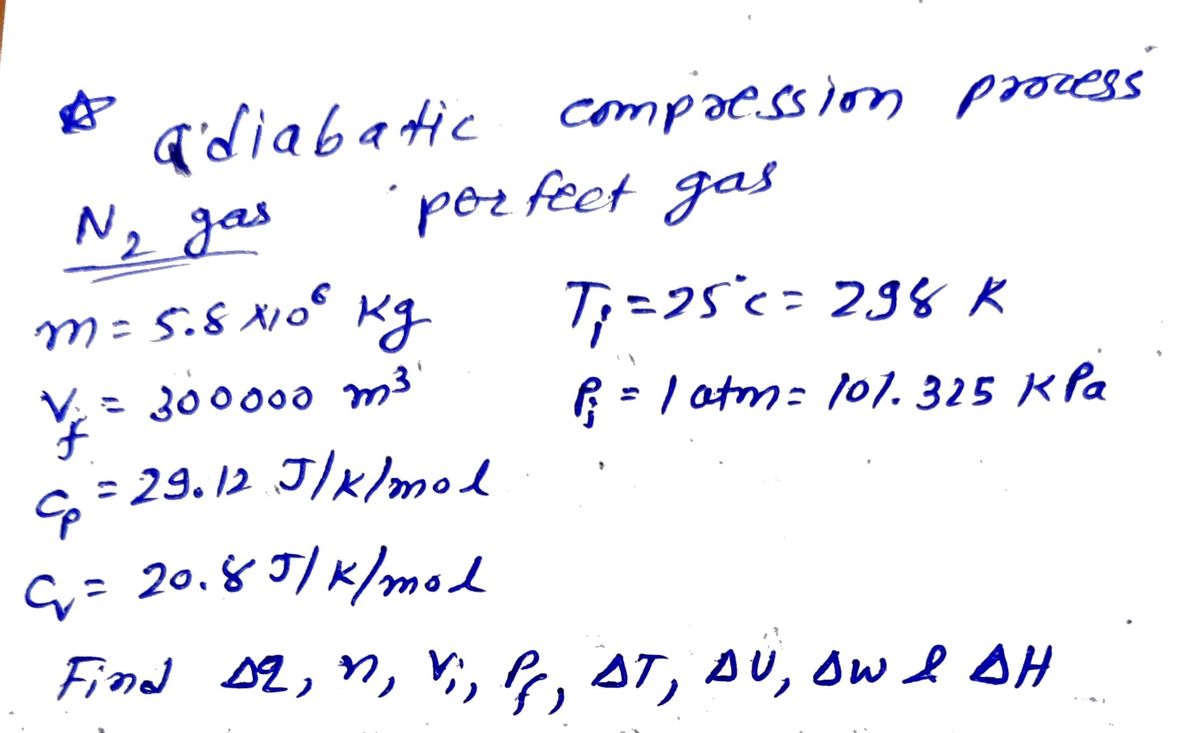One can store energy by compressing air and use it later to power a turbine to create energy when needed. The air must be heated to make this effective, which can be accomplished by compressing the air under adiabatic conditions. This is called adiabatic compressed air energy storage (CAES). Inside a typical power plant, 5.8×10^6 kg of N2 gas is at 25 °C is compressed from atmospheric to pressure into a volume of 300,000 m3 (they use abandoned salt mines). The process is done reversibly and adiabatically. What is q, n, Vi, Pf, T, U,w, and H and for this process? (Cp,m = 29.12 J/K/mol and Cv,m = 20.80 J/K/mol for N2). Assume perfect gas behavior
One can store energy by compressing air and use it later to power a turbine to create energy when needed. The air must be heated to make this effective, which can be accomplished by compressing the air under adiabatic conditions. This is called adiabatic compressed air energy storage (CAES). Inside a typical power plant, 5.8×10^6 kg of N2 gas is at 25 °C is compressed from atmospheric to pressure into a volume of 300,000 m3 (they use abandoned salt mines). The process is done reversibly and adiabatically. What is q, n, Vi, Pf, T, U,w, and H and for this process? (Cp,m = 29.12 J/K/mol and Cv,m = 20.80 J/K/mol for N2). Assume perfect gas behavior
Elements Of Electromagnetics
7th Edition
ISBN:9780190698614
Author:Sadiku, Matthew N. O.
Publisher:Sadiku, Matthew N. O.
ChapterMA: Math Assessment
Section: Chapter Questions
Problem 1.1MA
Related questions
Question
One can store energy by compressing air and use it later to power a turbine to create energy
when needed. The air must be heated to make this effective, which can be accomplished by compressing the air under adiabatic conditions. This is called adiabatic compressed air energy storage (CAES). Inside a typical power plant, 5.8×10^6 kg of N2 gas is at 25 °C is compressed from atmospheric to pressure into a volume of 300,000 m3 (they use abandoned salt mines). The process is done reversibly and adiabatically. What is q, n, Vi, Pf, T, U,w, and H and for this process? (Cp,m = 29.12 J/K/mol and Cv,m = 20.80 J/K/mol for N2). Assume perfect gas behavior.
Expert Solution
Step 1

Step by step
Solved in 3 steps with 3 images

Knowledge Booster
Learn more about
Need a deep-dive on the concept behind this application? Look no further. Learn more about this topic, mechanical-engineering and related others by exploring similar questions and additional content below.Recommended textbooks for you

Elements Of Electromagnetics
Mechanical Engineering
ISBN:
9780190698614
Author:
Sadiku, Matthew N. O.
Publisher:
Oxford University Press

Mechanics of Materials (10th Edition)
Mechanical Engineering
ISBN:
9780134319650
Author:
Russell C. Hibbeler
Publisher:
PEARSON

Thermodynamics: An Engineering Approach
Mechanical Engineering
ISBN:
9781259822674
Author:
Yunus A. Cengel Dr., Michael A. Boles
Publisher:
McGraw-Hill Education

Elements Of Electromagnetics
Mechanical Engineering
ISBN:
9780190698614
Author:
Sadiku, Matthew N. O.
Publisher:
Oxford University Press

Mechanics of Materials (10th Edition)
Mechanical Engineering
ISBN:
9780134319650
Author:
Russell C. Hibbeler
Publisher:
PEARSON

Thermodynamics: An Engineering Approach
Mechanical Engineering
ISBN:
9781259822674
Author:
Yunus A. Cengel Dr., Michael A. Boles
Publisher:
McGraw-Hill Education

Control Systems Engineering
Mechanical Engineering
ISBN:
9781118170519
Author:
Norman S. Nise
Publisher:
WILEY

Mechanics of Materials (MindTap Course List)
Mechanical Engineering
ISBN:
9781337093347
Author:
Barry J. Goodno, James M. Gere
Publisher:
Cengage Learning

Engineering Mechanics: Statics
Mechanical Engineering
ISBN:
9781118807330
Author:
James L. Meriam, L. G. Kraige, J. N. Bolton
Publisher:
WILEY